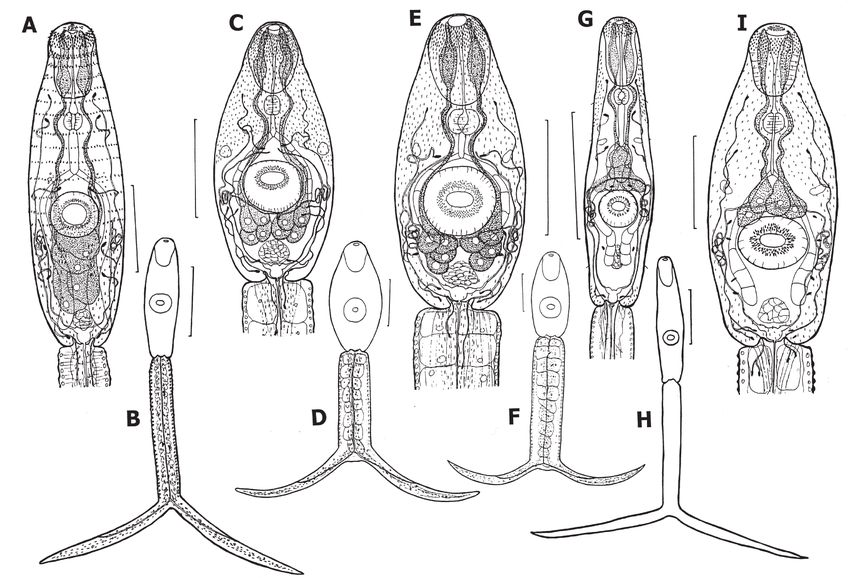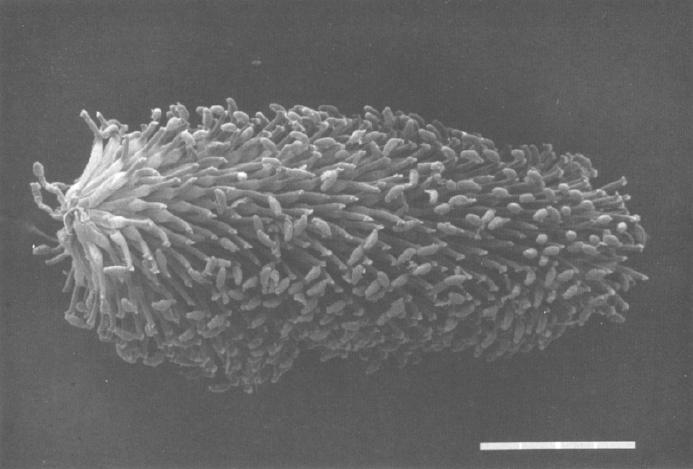from: BROWN
date: Monday, September 06, 2025 8:17 AM
subject: W.A.L.F. AQ34
So it looks like Corp wants to put the scramblers on hold for now. I know, I know, but we knew it was coming. At least it's for a project with a simpler goal: they want a way for XV3 to work on sharks, and easily spread throughout wild shark populations. I'm sure you can see the potential here. Xv3 as you know is the trematode line we tailored to terrestrial herbivores, but the majority of trematoda specialize in aquatic hosts already, so it's a simple shift. We just need to work out the simplest and most effective vector mechanism. What have you got for me?
from: Morris
date: Monday, September 06, 2025 10:00 AM
RE: W.A.L.F. AQ34
I propose we sample from Diplostomum pseudospathaceum[1], an easily accessible species with a number of advantages we were already experimenting with for the 00Z-1 project. Like a majority of marine flukes, the parasites develop first in gastropoda until they emerge as free swimming larvae (cercariae) and seek a fish as their next host, but pseudospathaceum is one of a few species to take up residence inside of the host's eyes. This is significant because the interior of the eyeball lacks lymph vessels and is largely closed off from the bloodstream, making it one of the easiest places in a living body for a parasite to remain undetected by the host. Since it doesn't need to adapt as carefully to the immune system of a given host, pseudospathaceum can infect a much wider variety of fish than most other trematoda. [2]
Convenience and adaptability aside, it is also one of the many flukes capable of modifying host behavior patterns. Infected fish spend more time actively swimming than resting or hiding, and swim closer to the water's surface where they're easily preyed upon by the parasite's final seabird hosts. We aren't seeking to affect birds, but I think with some adjustments we could tailor this process to sharks quite easily.
1: https://www.ncbi.nlm.nih.gov/pmc/articles/PMC4242471/
2: https://www.sciencedirect.com/science/article/abs/pii/S1567134811001249
ATTACHED:

https://www.researchgate.net/figure/Diplostomum-pseudospathaceum-A-B-Australapatemon-burti-C-D-Australapatemon-minor_fig1_6396510
from: Brown
date: Monday, September 06, 2025 9:05 AM
RE: RE: W.A.L.F. AQ34
Morris,
You're definitely on to something, but once we get our bug into Jabberjaw how does it spread? Normally the birds disperse the eggs in their droppings, most of the eggs get eaten by plankton, and just a tiny fraction find their way to snails on the sea floor. This is still a lengthy process, and I'm sure we can hack it so they go straight from the adult to the cercariae, spreading directly from shark to shark, can't we?
from: Morris
date: Monday, September 06, 2025 10:00 AM
RE: RE: RE: W.A.L.F. AQ34
I'm afraid that presents a few difficulties. Some forms of cercariae infect the host by penetrating tissues, but need to be quite small to do so, and XV3 can't be made much smaller without sacrificing signal strength. It's not a problem for domestic livestock hosts which are all but guaranteed by geographic location to wreak havoc even undirected, but in an environment as vast as the open ocean the client will need to maintain direct control over the host or it could wander for hundreds of miles in any direction without ever encountering human life, let alone the client's intended targets. That's a signal that will also have to penetrate water in addition to living tissue, so I'm afraid we're going to need fairly substantial "bugs."
Larger cercariae invade hosts via aggressive mimicry, moving in the water column and behaving similarly to the prey organisms of the desired host species (see attached). This is how we could get XV3 into the initial fish host, but it may not be a viable strategy for significantly larger host animals as the parasite itself would have to be large enough to capture their attention, and then we run into the opposite problem: if the parasite is too large, it won't have an easy route into the host brain without causing an undesirable degree of tissue damage.
I admit my knowledge of this subject is rather minimal outside the six species from our previous project, I can of course conduct further research into trematode life cycle strategies and get back to you.
ATTACHED:
Direct Video Source: Rafael Martin Ledo
from: Brown
date: Monday, September 06, 2025 10:18 AM
RE: RE: RE: RE: W.A.L.F. AQ34

http://dailyparasite.blogspot.com/2010/07/july-28-galactosomum-bearupi.html
No need, I already found something promising: zygocercous cercariae. This is an adaptation of the aggressive mimicry you're already talking about, except the worms form an aggregation, linking together to emulate a larger prey organism. Data seems limited and many of these species are still undescribed, but some years back there was even a video of what was eventually identified as one of these aggregating flukes:
https://twitter.com/rebeccarhelm/status/1423061993251131392
Almost looks like a baby octopus, doesn't it? These worms build themselves into an actual fishing lure. I've been deep sea fishing with my folks and we used squids to bait marlins, but we actually hooked a lot more sharks than anything else. What do you think?
from: Morris
date: Monday, September 06, 2025 10:35 AM
RE: RE: RE: RE: RE: W.A.L.F. AQ34
I think we're going in an acceptable direction. I believe we can modify XV3 to assimilate with Elasmobranchii, and quite possibly assemble aggregations of larvae in the host gut that emulate Decapodiformes or other desirable prey. We may benefit from field research before settling on the aggreggation's ideal specifications, and if my understanding of corporate is correct, we are almost guaranteed funding for the necessary experimentation if they are permitted to participate. It is evidently their favorite liesure activity, judging by expenditure reports, and I doubt they can resist an excuse to write it off as critical data collection.
from: Brown
date: Monday, September 06, 2025 11:00 AM
RE: RE: RE: RE: RE: RE: W.A.L.F. AQ34
...Are you suggesting we tell a bunch of suits that to develop a new bioweapon, we actually WANT them to get drunk and go fishing?
from: Morris
date: Monday, September 06, 2025 11:15 AM
RE: RE: RE: RE: RE: RE: RE: W.A.L.F. AQ34
I had not considered it in those terms, but they're not necessarily inaccurate. I believe such an arrangement may even be conducive to securing additional long-term resources applicable to more than project AQ34.
from: Brown
date: Monday, September 06, 2025 11:00 AM
RE: RE: RE: RE: RE: RE: RE: RE: W.A.L.F. AQ34
I know we're all here to find new ways we can kill people with worms, but sometimes you're really an evil genius.